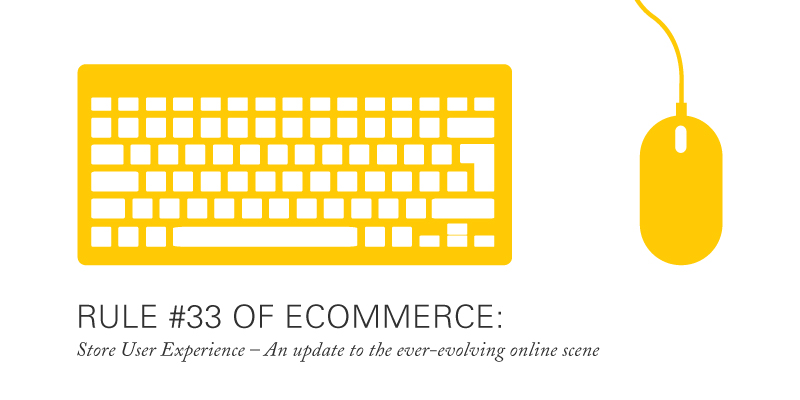
Rule #33 of eCommerce – an update on the ever-evolving online scene
by AvneetCreating a worthwhile user experience goes a long way from converting visitors into customers and customers into returning customers. As an online retailer, you have to always keep in mind that the eCommerce market is on the rise and there are other retailers out there offering lower prices or better incentives than you.
In this highly competitive scene, you’re battling against not only small to medium eCommerce stores but also online retail giants such as Amazon.com, eBay, or websites such as Groupon, that have completely changed the dynamics of online sales. In addition, online stores don’t have the customer interaction advantage of brick and mortar stores, which, by the way, are adapting fast to improve user experience through apps, eStore integration and the new-age Beacon technology. The bright side of things is that there’s a bit of time left, as 77% of mobile users are still showing reluctance towards being tracked in-store. That’s why you need to work on your online customer interaction features.
In this new light, the only way to rise above the rest is by offering the best user experience. Touch points need to be treated as potential selling points, but definitely not as selling battlefields. They will not result in direct revenue but will be crucial in influencing the user in making the buying decision. Touch points help in personalizing the interaction with the potential customer.
On your webstore there’s a cornucopia of messages addressing users. From your meta tags to auto-responders, search, checkout, social media proofs, customer stories, product descriptions, informational videos, the about page and contact page; these touch points if ignored can decrease the chances of a visitor converting into a customer.
How can you personalize eCommerce Touch Points?
1) Focus on customer lifetime value and retention
Here are some stats:
-
71% of consumers have ended their relationship with a company due to poor customer service. (KISSmetrics)
-
The probability of selling to an existing customer is 60 – 70%.
-
The probability of selling to a new prospect is 5-20% (Marketing Metrics)
-
Attracting a new customer can cost five times as much as keeping an existing one (Lee Resources 2010)
Improving the customer experience (a combination of different conversion rate optimization touch points) is high on the agenda for 64% of companies and 58% of agencies, according to a study made by Econsultancy in partnership with Sitecore. Focusing on this as a top priority, the study respondents made it their most important strategy for increasing CLV in the future. In addition, given today’s consumer behavior changes due to the interconnectivity of it all, a shift towards a finely tuned customer service and personalization is needed. So, it’s no surprise that 32% of companies rate the single customer view as the best tool to improve the customer lifetime value.
A fully optimized and personalized customer service is becoming more and more consequential, as consumer demands are becoming more complex. You should pay as much attention to retention as you do to acquisition. Rewards for customer loyalty and personalized, relevant offers are starting to work very well. The tools, the information is out there, stored as Big Data and learning how to harness it will give you the competitive edge.
2) Focus on pre-transactional conversion
You always strive to increase conversion rates on your eStore. The challenge for most of us is falling into a loop and focusing ourselves on one customer life-cycle stage, thus forgetting about the other stages. If you are willing to take a step back and look at the landscape, you can gain some insight on where to capitalize next.
Pre-transactional conversion has many uses. Firstly, it will help you build a steady contact database. Most websites have a low visitor-to-contact conversion rate because they offer only two opportunities to collect contact data: newsletter and purchases.
“When an e-commerce site offers many pre-transactional conversion points for specific personas and at all stages of the buying cycle, they will dramatically increase the amount of conversions they complete and new contacts in their database.” – Luke Summerfield
Creating a lead conversion very early in the consumer’s lifecycle and nurturing that lead will slowly but surely help build a relationship of trust and credibility. Personalized interaction via email, social and various apps will bridge the gap between your consumers and your brand by helping develop positive feelings towards one another.
3) Focus on a unique shoppers experience
All of us have shopped in eStores where the chat pops up persistently or the first thing you see is a pop-up urging you to subscribe to the email list. After skipping them, you continue to shop or browse. However, if they reappear you’ll leave the site without giving it a second thought.
According to Tom Kwon there are three core drivers for consumer purchases: affirmation, information and inspiration. Shopping online is convenient, yet there’s nothing like a shopping day with your friends. Shopping in physical stores with friends, you can get instant, trusted feedback for all purchases. You can ask strangers for opinions or ideas and you can see firsthand which items are sold like fresh bread. And a question arises: how do you replicate the physical experience to the online scene? From this idea Tom started up Blucarat, a platform that activates social engagement between shoppers directly on the website.
Our advice? You can start by shopping on some of the big online stores and see who is doing it right or better yet, shop at your own store like a customer and see where you can improve and improvise.
Personalization is paramount. It offers the lowest level of annoyance and it delivers the highest upside. The trick is to have a solid base of current data and use it wisely. This is especially true if you recognize your shoppers with certainty and you can present products or offers that align with their past behavior. On the other hand, creating the same level of user interaction, as in the physical world, can drive the same behavioral patterns in online.
Predicting how consumers react to marketing tactics is like Russian Roulette. A big gamble. The game is not to control, but to monitor and make informed decisions on how to go about it.
Ultimately, online marketing is part crunching numbers, part art. Finding the proper balance to drive revenue without alienating your customers is the ultimate goal. Use your own instincts here, because failing to reach that balance may put your brand at risk in the long run.
- About the Author
- Latest Posts
-
Jiva’s Organic Traffic Growth: 354% Surge in 6 Months | CueForGood
by Nida DanishSummary: Jiva’s efforts to empower smallholder farmers weren’t gaining the digital traction they deserved. With a strategic overhaul led by …
Continue reading “Jiva’s Organic Traffic Growth: 354% Surge in 6 Months | CueForGood”
-
What We Learned When We Switched From Disposable Tissues to Reusable Napkins
by Nida DanishAt CueForGood (CFG), we’ve embraced a refreshing change: reusable cloth napkins. While the switch may seem minor, it’s rooted in …
Continue reading “What We Learned When We Switched From Disposable Tissues to Reusable Napkins”
-
Of Light, Laughter & Transformation: Diwali 2024 at Cue For Good
by Nida Danish
On any given day, walking into the Cue For Good office feels like stepping into a space with heart. It’s …
Continue reading “Of Light, Laughter & Transformation: Diwali 2024 at Cue For Good”
-
Why PHP Still Matters in 2024: A Look at Its Continued Relevance
by Girish TiwariAt its peak in the early 2010s, PHP powered the majority of websites globally, including major platforms like Facebook and …
Continue reading “Why PHP Still Matters in 2024: A Look at Its Continued Relevance”
-
How Meta’s New Holiday Ad Features Can Transform Your Business This Season
by Charanjeev SinghThis year, Tapcart’s 2024 BFCM Consumer Trends Report suggests that nearly 60% of shoppers kick off their holiday shopping in …
Continue reading “How Meta’s New Holiday Ad Features Can Transform Your Business This Season”
-
Cue For Good’s Journey at the B Corp Festival 2024: Exploring Louder Than Words
by Pancham PrasharOn September 10th and 11th, 2024, I had the incredible experience at the “Louder Than Words” B Corp Festival, held …
Continue reading “Cue For Good’s Journey at the B Corp Festival 2024: Exploring Louder Than Words”








